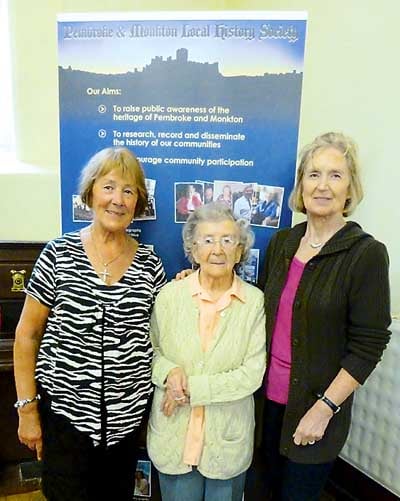The circumstances could not have been more different. Our new prince was born amid media frenzy and public rejoicing, while young Henry Tudor was born into dark and dangerous times. Unlike the radiant Kate, Henry's mother was a frightened, 13-year-old child, sent to Pembroke to seek safety in the protection of her brother in law Jasper. Her husband Edmund Tudor Earl, of Richmond, was dead, killed in the power struggle we call the Wars of the Roses (called as such by the novelist Sir Walter Scott because the emblem of Lancaster was a red rose and that of York was a white one). They had found themselves on the losing side, supporting the deposed King Henry VI against the triumphant Yorkists. Henry VI was Edmund's half-brother.
Jasper continued to fight for the Lancastrian cause and was stripped of the Earldom of Pembroke in 1461. William Herbert replaced Jasper, becoming the first Welshman to hold the title, and he gained custody of young Henry whom he planned to marry to his own daughter. However, in July 1469, he was captured and beheaded by the Lancastrians after the Battle of Edgecote Moor, near Banbury.
Although Henry's claim to the throne was flimsy, the Battle of Tewkesbury in 1471 resulted in the death of Henry VI's son and heir, Edward Prince of Wales. All eyes turned to Henry Richmond as the next best Lancastrian candidate: his life henceforth was in danger. Jasper took the teenage Henry with him into exile, escaping first to Tenby, where they were welcomed by the Mayor, Thomas White, and then to exile in Brittany from whence he launched his invasion which culminated in the Battle of Bosworth 1485. Richard was killed and Henry crowned on the battlefield.
A Royal statue?
Perhaps this is the time that Royal Pembroke should press ahead for a statue to our king. Clr. Mel Phillips has been a strong campaigner for this and I asked her for her comment: "It is disgraceful that we do not have a statue to Henry VII. He was undisputedly one of the greatest kings to sit on the British throne and brought peace and prosperity to this country, a country which had been torn apart by civil war. Historically too his reign marks the end of the Middle Ages and the formation of the modern state. We are the only town in Britain not to have a statue to a monarch born there - so what better way to commemorate this Royal birth than raise a statue to Henry VII!"
Society news
At least we now have an opportunity to celebrate our heritage in the museum project in the Town Hall. We have also this week been invited to put a display in the window next to Brown's Fish and Chip café which we successfully did last summer. We aim to change the displays on a regular basis and have made a start with a display about the Pembroke and Tenby Railway. As I have written about in the past, 2013 is the 150th anniversary of its opening on July 30, 1863: this is in the way of a taster of the main exhibition in the Town Hall museum. Here too we can advertise our events and keep in touch with you. We would like to give a big thank you to Hilton, Glenys and Steve Brown for the opportunity to do this.
Pembroke Railway
The museum project has proved a successful community affair, giving heritage groups the opportunity to work together and reach out to the community and help promote and research our history. It is also an avenue for the community to respond by bringing in material which can add to our knowledge about Pembroke and district.
Here, I should particularly like to thank Graham Davies for his contribution. Graham who lives in Scotland, has a particular interest in the Pembroke and Tenby Railway and on hearing that we were setting up the museum has very generously sent us a copy of the book he has written and not yet published. It is a marvellous gift and presented in a hard folder so that it can be consulted by interested persons visiting the museum. Graham was also responsible for the presentation 'Pembrokeshire in old picture postcards' which was introduced by his aunt, Nancy Davies, at the opening of the Pembroke Museum Project.
Memories of Pembroke Railway
Graham's book traces the story of Pembroke's Railway from the formation of the Pembroke and Tenby Railway Company to the present day.
In his introduction, Graham writes of his love for his local branch line stemming from his childhood fascination for the railway and his thrill at moving to Station Road in 1957 which enabled him to keep a close eye on the comings and goings on the station. He writes: "The reward for all this close scrutiny was to be invited up onto the footplate of baby prairie 5520 at the grand old age of 11! For me, and for countless others of my age group, past and present, it was a wonderful prize, to be accepted by the engine driver and crew alike. The glory of that first foot plating will forever live in my mind, pulling on the whistle chain and then heaving on the not so easy to open regulator to make the train move (with perhaps a little help form the driver)! The feeling of the power that surged through the engine as she increased that certain gusto that surely the Great Western baby prairie Class had and will always have as long as there are some active locomotives in preservation, as she started out on the long journey from Pembroke to Pembroke Dock! It was more like Paddington to Pembroke Dock!
My little heaven was entered that day as she sped on her way to the Dock, over the embankment , separating the upper and lower mill ponds, passed the site of Golden Hill Halt and then through that long tunnel and into the terminus. The feel of the firebox, glowing throughout the journey in the tunnel, the sounds and squeals as she thundered on her way! On arrival at the Dock, to be kept out of sight of the Station Master so that I could journey back to Pembroke. Bliss!"
Graham's book traces the fortunes of the P & T Line, from the formation of the Company, its takeover by the Great Western Railway then British Rail to the replacement of those wonderful steam trains by the DMUs (Diesel Multiple Units) to present day. It contains also a List of the Acts of Parliament relating to the Company and Articles of Agreement, details of locomotives and rolling stock, signal box diagrams, tickets and timetables and much more, including many photograph of the trains and stations. In short, a valuable resource.
Contact
If you have any stories or photographs for this column, please contact me, Linda Asman, on 01646 622428, email [email protected]">[email protected] and visit our website http://www.pembrokeandmonktonhistory.org.uk">www.pembrokeandmonktonhistory.org.uk





Comments
This article has no comments yet. Be the first to leave a comment.